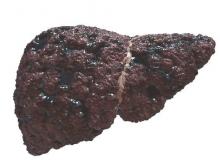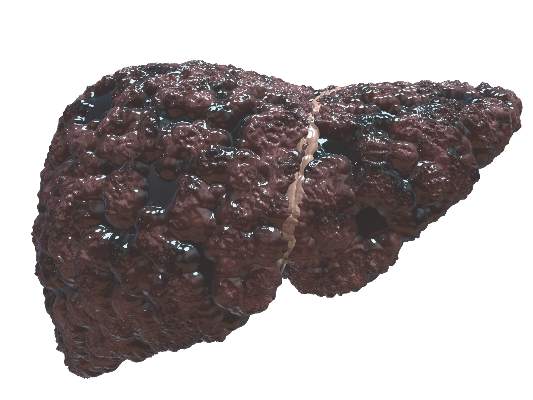User login
The development and progression of fatty liver, and alcoholic and nonalcoholic diseases appear to be influenced by gut microbiota but it is too early to say whether microbial therapy could be used to treat patients, experts have concluded in a review of the literature.
In a study published in Gastroenterology (2016. doi: 10.1053/j.gastro.2016.02.073), Ph.D. student Naga S. Betrapally and Patrick M. Gillevet, Ph.D., of the microbiome analysis center at George Mason University in Fairfax, Va., together with colleague Dr. Jasmohan S. Bajaj of the Virginia Commonwealth University in Richmond looked at whether changes in the intestinal microbiome and alcoholic and nonalcoholic liver diseases were causes of the disease or effects.
Researchers had found that intestinal microbiota affected precirrhotic and cirrhotic stages of liver disease, the review authors said.
For example, one way in which gut microbiota might influence the severity of nonalcoholic fatty liver disease (NAFLD) was by “increasing production of ethanol, activating TLR [toll-like receptor] signaling and TNF [tumor necrosis factor] production in the liver, or altering the bile acid profile,” they said.
Researchers had also found that changes to intestinal microbiota could have an impact on the development of nonalcoholic steatohepatitis by affecting processes like digestion, immune response, and the production of gut hormones.
Microbial therapies such as antibiotics, synbiotics, probiotics, and prebiotics could be developed to treat patients with NAFLD and alcoholic liver disease (ALD), they noted.
For instance, short-term use of Bifidobacterium bifidum and Lactobacillus plantarum 8PA3 in alcoholic patients was shown to lower plasma levels of alanine aminotransferase and aspartate aminotransferase, restore intestinal microbiota, and reduce alcohol-related liver injuries.
However, they cautioned that NAFLD and ALD were “multiorgan diseases that also involve metabolic syndrome and the widespread effects of alcohol.”
Furthermore, the composition of the intestinal microbiome varies widely among individuals and different ethnic groups, and “its effects on the development of liver disease involve additional environmental, dietary, genetic, social, and behavioral factors,” they said.
“Although substantial progress has been made in increasing our understanding of the gut microbiota in patients with alcoholic and nonalcoholic steatohepatitis, many important questions remain,” they concluded.
“Large multicenter studies of many patients, over long time periods, are needed to determine how the microbiota might cause liver disease and how liver disease alters the microbiota,” they added.
The development and progression of fatty liver, and alcoholic and nonalcoholic diseases appear to be influenced by gut microbiota but it is too early to say whether microbial therapy could be used to treat patients, experts have concluded in a review of the literature.
In a study published in Gastroenterology (2016. doi: 10.1053/j.gastro.2016.02.073), Ph.D. student Naga S. Betrapally and Patrick M. Gillevet, Ph.D., of the microbiome analysis center at George Mason University in Fairfax, Va., together with colleague Dr. Jasmohan S. Bajaj of the Virginia Commonwealth University in Richmond looked at whether changes in the intestinal microbiome and alcoholic and nonalcoholic liver diseases were causes of the disease or effects.
Researchers had found that intestinal microbiota affected precirrhotic and cirrhotic stages of liver disease, the review authors said.
For example, one way in which gut microbiota might influence the severity of nonalcoholic fatty liver disease (NAFLD) was by “increasing production of ethanol, activating TLR [toll-like receptor] signaling and TNF [tumor necrosis factor] production in the liver, or altering the bile acid profile,” they said.
Researchers had also found that changes to intestinal microbiota could have an impact on the development of nonalcoholic steatohepatitis by affecting processes like digestion, immune response, and the production of gut hormones.
Microbial therapies such as antibiotics, synbiotics, probiotics, and prebiotics could be developed to treat patients with NAFLD and alcoholic liver disease (ALD), they noted.
For instance, short-term use of Bifidobacterium bifidum and Lactobacillus plantarum 8PA3 in alcoholic patients was shown to lower plasma levels of alanine aminotransferase and aspartate aminotransferase, restore intestinal microbiota, and reduce alcohol-related liver injuries.
However, they cautioned that NAFLD and ALD were “multiorgan diseases that also involve metabolic syndrome and the widespread effects of alcohol.”
Furthermore, the composition of the intestinal microbiome varies widely among individuals and different ethnic groups, and “its effects on the development of liver disease involve additional environmental, dietary, genetic, social, and behavioral factors,” they said.
“Although substantial progress has been made in increasing our understanding of the gut microbiota in patients with alcoholic and nonalcoholic steatohepatitis, many important questions remain,” they concluded.
“Large multicenter studies of many patients, over long time periods, are needed to determine how the microbiota might cause liver disease and how liver disease alters the microbiota,” they added.
The development and progression of fatty liver, and alcoholic and nonalcoholic diseases appear to be influenced by gut microbiota but it is too early to say whether microbial therapy could be used to treat patients, experts have concluded in a review of the literature.
In a study published in Gastroenterology (2016. doi: 10.1053/j.gastro.2016.02.073), Ph.D. student Naga S. Betrapally and Patrick M. Gillevet, Ph.D., of the microbiome analysis center at George Mason University in Fairfax, Va., together with colleague Dr. Jasmohan S. Bajaj of the Virginia Commonwealth University in Richmond looked at whether changes in the intestinal microbiome and alcoholic and nonalcoholic liver diseases were causes of the disease or effects.
Researchers had found that intestinal microbiota affected precirrhotic and cirrhotic stages of liver disease, the review authors said.
For example, one way in which gut microbiota might influence the severity of nonalcoholic fatty liver disease (NAFLD) was by “increasing production of ethanol, activating TLR [toll-like receptor] signaling and TNF [tumor necrosis factor] production in the liver, or altering the bile acid profile,” they said.
Researchers had also found that changes to intestinal microbiota could have an impact on the development of nonalcoholic steatohepatitis by affecting processes like digestion, immune response, and the production of gut hormones.
Microbial therapies such as antibiotics, synbiotics, probiotics, and prebiotics could be developed to treat patients with NAFLD and alcoholic liver disease (ALD), they noted.
For instance, short-term use of Bifidobacterium bifidum and Lactobacillus plantarum 8PA3 in alcoholic patients was shown to lower plasma levels of alanine aminotransferase and aspartate aminotransferase, restore intestinal microbiota, and reduce alcohol-related liver injuries.
However, they cautioned that NAFLD and ALD were “multiorgan diseases that also involve metabolic syndrome and the widespread effects of alcohol.”
Furthermore, the composition of the intestinal microbiome varies widely among individuals and different ethnic groups, and “its effects on the development of liver disease involve additional environmental, dietary, genetic, social, and behavioral factors,” they said.
“Although substantial progress has been made in increasing our understanding of the gut microbiota in patients with alcoholic and nonalcoholic steatohepatitis, many important questions remain,” they concluded.
“Large multicenter studies of many patients, over long time periods, are needed to determine how the microbiota might cause liver disease and how liver disease alters the microbiota,” they added.
FROM GASTROENTEROLOGY
Key clinical point: Although substantial progress has been made in the understanding of the gut microbiota in patients with alcoholic and nonalcoholic steatohepatitis many important questions remain.
Major finding: Large multicenter studies involving many patients over long time periods are needed to determine how the microbiota might cause liver disease and how liver disease alters the microbiota.
Data source: A review of the literature on the differences and similarities in the cirrhotic and precirrhotic stages of NAFLD and ALD and the role of intestinal microbiota.
Disclosures: No conflicts of interest were declared.

